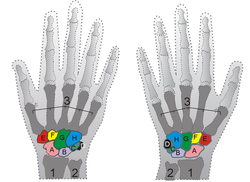अल्ना
| अल्ना क्वँय् | |
|---|---|
 | |
| अपर एक्स्ट्रेमिटी | |
 | |
| अल्ना #२ ख | |
| Gray's | subject #52 214 |
| MeSH | अल्ना |
अल्ना (एल्बो बोन) छगू लङ्ग बोन ख। थ्व प्रिज्म्याटिक आकारया जुइ व फोरआर्मया मेडियल सिथय् दै। थ्व क्वें रेडियसया प्यारालल दयाच्वनि।
आर्टिकुलेसन
[सम्पादन]अल्नाया आर्टिकुलेसन थ्व कथं दु:
- ह्युमरस, प्रोक्जिमल्ली एल्बो जोर्नीइ हिञ्ज जोर्नीया स्वापूलि।
- रेडियस, एल्बोनापं पाइभोट जोर्नीया स्वापूलि, थुकिलिं याना रेडियसं अल्नायात प्रोनेसनय् क्रस ओभर याये छिनि।
- डिस्टल रेडियस नाप अल्नर नोचय् स्वापू।
- रेडियस नाप रेडियस व अल्नाया हाकलिं हे इन्टरओस्सियस मेम्ब्रेनं सिन्डिस्मोसिस जोर्नीया कथं स्वापू दयाच्वनि।
Proximal and distal aspects
[सम्पादन]The ulna is broader proximally, and narrower distally.
Proximally, the ulna has a bony process, the olecranon process, a hook-like structure that fits into the olecranon fossa of the humerus. This prevents hyperextension and forms a hinge joint with the trochlea of the humerus. There is also a radial notch for the head of the radius, and the ulnar tuberosity to which muscles can attach.
Distally (near the hand), there is a styloid process.
Structure
[सम्पादन]The long, narrow medullary cavity is enclosed in a strong wall of compact tissue which is thickest along the interosseous border and dorsal surface.
At the extremities the compact layer thins.
The compact layer is continued onto the back of the olecranon as a plate of close spongy bone with lamellæ parallel.
From the inner surface of this plate and the compact layer below it trabeculæ arch forward toward the olecranon and coronoid and cross other trabeculæ, passing backward over the medullary cavity from the upper part of the shaft below the coronoid.
Below the coronoid process there is a small area of compact bone from which trabeculæ curve upward to end obliquely to the surface of the semilunar notch which is coated with a thin layer of compact bone.
The trabeculæ at the lower end have a more longitudinal direction.
Muscle attachments
[सम्पादन]| Muscle | Direction | Attachment |
| Triceps brachii muscle | Insertion | Olecranon process (via common tendon) |
| Anconeus muscle | Insertion | Olecranon process (lateral aspect) |
| Brachialis muscle | Insertion | Coronoid process of the ulna |
| Pronator teres muscle | Origin | Coronoid process (also shares origin with medial epicondyle of the humerus) |
| Flexor carpi ulnaris muscle | Origin | Olecranon process and posterior surface of ulna (also shares origin with medial epicondyle of the humerus) |
| Flexor digitorum superficialis muscle | Origin | Coronoid process (also shares origin with medial epicondyle of the humerus and shaft of the radius) |
| Flexor digitorum profundus muscle | Origin | Coronoid process, anteromedial surface of ulna (also shares origin with the interosseous membrane) |
| Pronator quadratus muscle | Origin | Distal portion of anterior ulnar shaft |
| Extensor carpi ulnaris muscle | Origin | Posterior border of ulna (also shares origin with lateral epicondyle of the humerus) |
| Supinator muscle | Origin | Proximal ulna (also shares origin with lateral epicondyle of the humerus) |
| Abductor pollicis longus muscle | Origin | Posterior surface of ulna (also shares origin with the posterior surface of the radius bone) |
| Extensor pollicis longus muscle | Origin | Dorsal shaft of ulna (also shares origin with the dorsal shaft of the radius and the interosseous membrane) |
| Extensor pollicis brevis muscle | Origin | Dorsal shaft of ulna (also shares origin with the dorsal shaft of the radius and the interosseous membrane) |
| Extensor indicis muscle | Origin | Posterior surface of distal ulna (also shares origin with the interosseous membrane) |
स्वयादिसँ
[सम्पादन]Additional images
[सम्पादन]-
Ulna l. dx. - ant. view
-
Ulna l. dx. - lat. view
-
Right posterior human radius and ulna
-
Human arm bones diagram
-
Bones of left forearm. Anterior aspect.
-
The radius and ulna of the left forearm, posterior surface.
-
Left elbow-joint, showing anterior and ulnar collateral ligaments.
-
Cross-section through the middle of the forearm.
-
The Supinator.
-
Transverse section across distal ends of radius and ulna.
External links
[सम्पादन]
| ||||||||||||||||||||||||||||||||||||||||||||||||||||||||||||||
This article was originally based on an entry from a public domain edition of Gray's Anatomy. As such, some of the information contained within it may be outdated.
| ||||||||||||||||||||||||||||
| विकिमिडिया मंका य् थ्व विषय नाप स्वापु दुगु मिडिया दु: Ulna |







